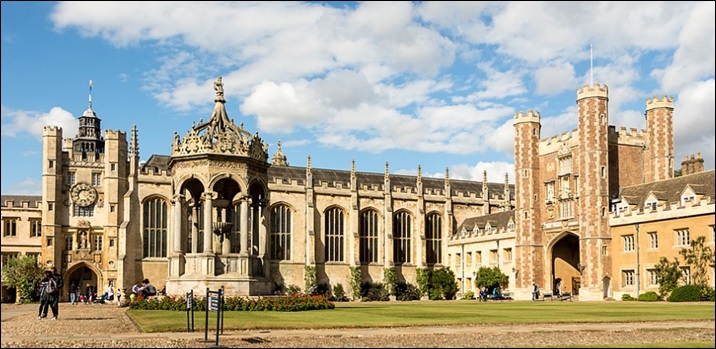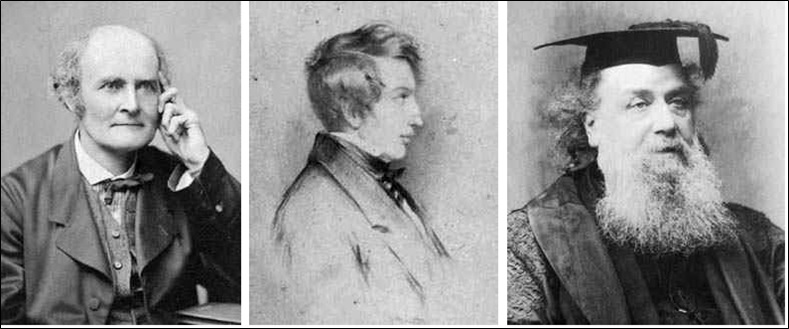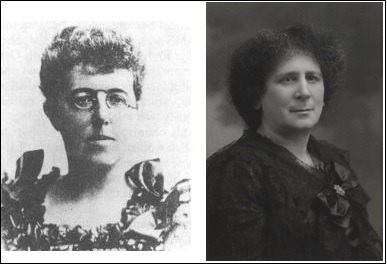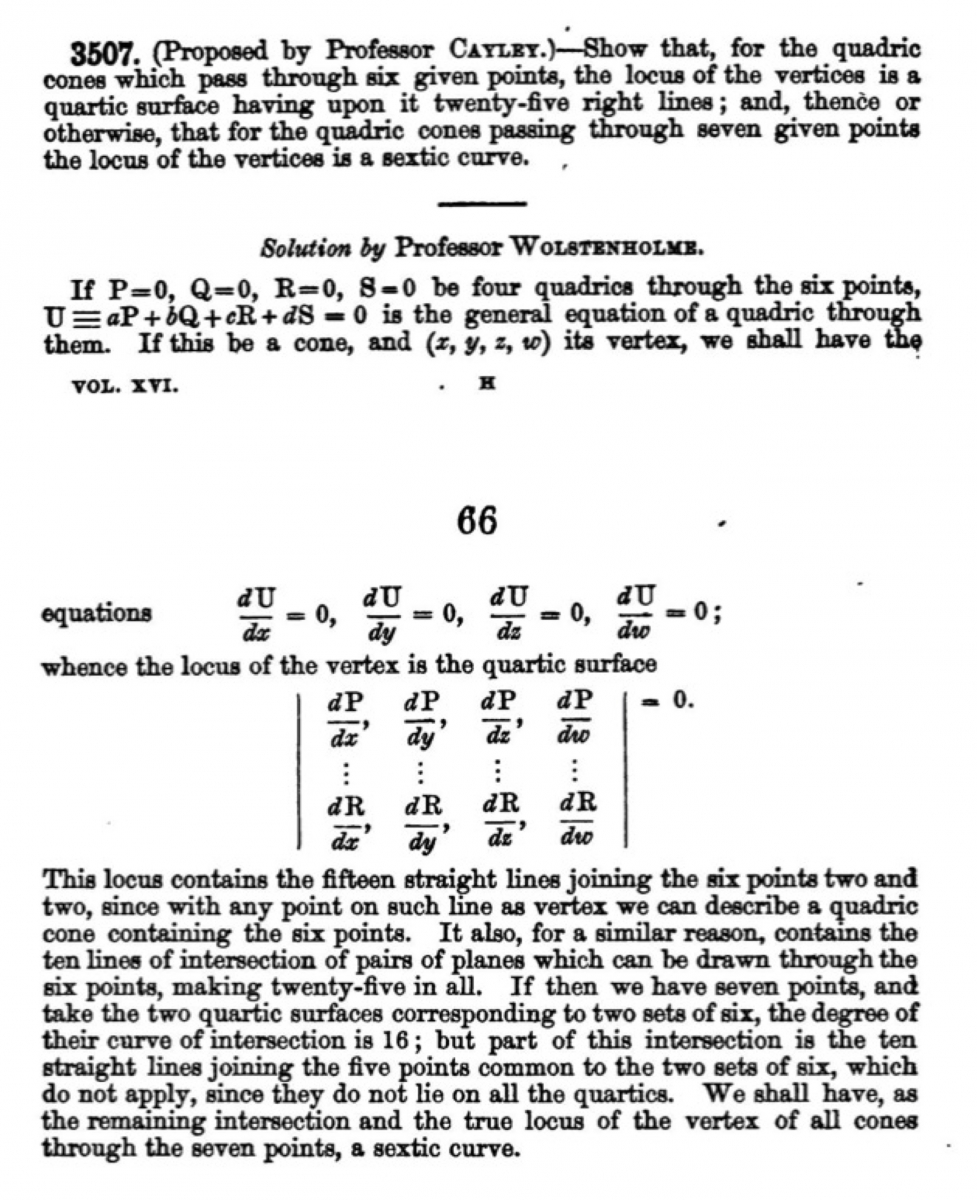The Educational Times Database: History of the Educational Times and Mathematical Questions, 1847–1918
The following three subsections provide an overview of the importance of the ET (and its offshoot MQ) and its contributors to the history of mathematics:
When the collective contents and widespread readership of the ET and MQ are appraised together, their historical significance is clear. The ET and MQ were read seriously by many of the nineteenth century’s leading mathematicians. It is hoped that this brief history illuminates the role of the ET/MQ in British and transnational mathematics communities, as well as shows how the journals validated women’s participation in a profession that typically excluded or marginalized women. No definitive history of the ET/MQ yet exists, but more details on the journals, their readers, editors, printers, and publisher can be found in excellent articles by Janet Delve [2003], Sloan Despeaux [2017], Ivor Grattan-Guinness [1992], and Shawnee McMurran and James Tattersall [2004]. These articles cannot be recommended highly enough for readers interested in the ET/MQ. They offer inspiration and encouragement for scholars to pursue further research on a remarkable pair of historic journals.
The Educational Times Database: Founding of the Journals and Early Contributors
In 1846, a “group of committed private Schoolmasters” in England founded the College of Preceptors, a distinctly nonsectarian, secular institution dedicated to improving the quality of teachers in Britain [Delve 2003, 145]. In practical terms, the College provided training to aspiring teachers and administered exams which, if passed, resulted in a certificate of advanced academic ability and teaching skill. The College published the journal ET as a way to share news of the College itself, to circulate the newest teaching methods to its teacher-readers, to advance the professionalization of the teaching occupation, and to publish the latest research on a variety of scientific topics [Delve 2003, 151]. One of these topics was mathematics. Although the ET’s mathematics section started out as a didactic tool “to demonstrate solid methods to assist both teachers and students,” over time it also accommodated a spirit of competition among sporting mathematicians—among both women and men, professors and lay people [Despeaux 2017, 222]. Mathematics became such a popular topic that the College began issuing the MQ in 1864, which reprinted and expanded much of the ET’s mathematical content.

Figure 4. Images of the May 1861 issue of the ET and one of two 1864 volumes of MQ.
Images collected via the “References” tab at https://educational-times.wcu.edu/.
The ET emerged in the historical setting of Victorian England, an era which began in 1837 when eighteen-year-old Victoria, of the royal House of Hanover, assumed the throne. She succeeded her deceased uncle, the reformer King William IV (r. 1830–1837), and her grandfather King George III (r. 1760–1820). Over a long reign, King George III had presided over the creation of the United Kingdom of Great Britain and Ireland, witnessed industrial revolution, fought the creation of the United States, and won an epic war against Napoleonic France. Following an age of wars and political reforms, Victorian-era Britain was comparatively peaceful. Abroad, however, this was the height of the British empire, with its ruthlessly exploitative policies towards other countries. Yet at the same time, the empire facilitated cultural and intellectual exchange across continents; in mathematics, Britain had much to offer, as the “Victorian period coincided with a revival” of the discipline after “its mid-18th-century slump” [Rice 2011, 3].
The center of mathematical activity in Victorian Britain was Cambridge University, where the College of Preceptor’s Board of Examiners for Mathematics was based. The university had made mathematics a central part of its general curriculum in the mid-eighteenth century, instituting the Mathematical Tripos, a course of study that culminated in the Tripos final examination [Crilly 2011, 19–20]. Each year, the top scorers on the exam had the honor of being ranked as “wranglers,” further sub-ranked from “senior wrangler” to “second wrangler,” “third wrangler,” and so on. Among the early-nineteenth-century Cambridge mathematicians who went on to influence the mathematical renaissance of the Victorian era were John Herschel (1792–1871), George Peacock (1791–1858), and Charles Babbage (1791–1871) [MacTutor]. In the 1812 tripos exams, Herschel and Peacock were senior and second wranglers, respectively. In 1811 the trio had co-founded the Analytical Society at Cambridge, which famously promoted wider adoption of French and German approaches to calculus and algebra in Britain. The activities of Analytical Society members were diverse and impactful even though the group only met formally for about a year. Collectively, the Society translated several continental European mathematics papers into English. Individually, Peacock redefined a branch of mathematics in his 1830 Treatise on Algebra, the same year that Herschel published the well-received Discourse on Natural Philosophy, and around the time that Babbage began designing his “analytical engine, the forerunner of the modern electronic computer” [MacTutor].

Figure 5. A view of Trinity College, Cambridge, where Charles Babbage, John Herschel,
and George Peacock matriculated in the early 1810s [Esteve 2016].
The students of Herschel, Peacock, and Babbage were the ones who, in the early Victorian era, would drive the rise of mathematical research and pedagogy and contribute to the ET’s mathematical section. For example, among the top half-dozen wranglers in the 1837 Tripos exam were J. J. Sylvester (1814–1897), George Green (1793–1842), Duncan Gregory (1813–1844), and A. J. Ellis (1814–1890) [Crilly 2011, 20]. Before his untimely death in 1844, at age thirty, Gregory wrote important papers that expanded on Peacock’s algebraic treatise; he also mentored and influenced the mid-Victorian algebraist George Boole; and he served as founding editor of The Cambridge Mathematical Journal in 1837 [Rice 2011, 4–5; MacTutor]. Although that journal floundered after Gregory’s death, it was revived in 1846 as The Cambridge and Dublin Mathematical Journal, which shared contributors with the ET [Crilly 2011, 24]. J. J. Sylvester, meanwhile, was not granted a degree from Cambridge because his Jewish faith prevented him pledging an oath to the Church of England, as was required of graduates at that time [MacTutor]. In 1841, finally, Sylvester earned degrees at Trinity College, Dublin. But when he began applying for faculty positions, his Cambridge professors Herschel and Babbage served as professional references. The Cambridge network remained strong. About twenty years older than Sylvester and Gregory—in fact, about the same age as the elder teachers Herschel, Peacock, and Babbage—was George Green, a self-taught and non-degreed mathematician (prior to attending Cambridge). Green became an undergraduate at Cambridge only at age forty, in 1833, after some of his published papers gained the attention of the Analytical Society founders [MacTutor].
Another early Victorian mathematician of note, who ranked as senior wrangler in the 1842 Tripos exam, was Arthur Cayley (1821–1895), whom Peacock had tutored [MacTutor]. So impressed with Cayley was Duncan Gregory, then the editor of The Cambridge Mathematical Journal, that he published several of Cayley’s undergraduate papers. In the 1850s, Cayley and J. J. Sylvester collaboratively developed invariant theory in algebra, describing a class of algebraic expressions that retain their basic form even when subjected to transformations [Rice 2011, 6]. Cayley and Sylvester’s theory provides just one example of the importance of this generation of British mathematicians to mathematical innovation. These pioneering Victorian mathematicians—Sylvester, Green, Ellis, and Cayley, although not the prematurely deceased Gregory—were among the ET’s earliest contributors. Thus, the ET quickly became an important forum for innovative British mathematicians. At this juncture, it bears repeating that apart from the great British men of the era, whose careers are already well-documented, women, non-Brits, and many anonymous individuals also found a welcoming forum for their mathematical passions in the ET.

Figure 6. A few of the notable Cambridge mathematicians who matriculated in the early Victorian period.
From left to right: Arthur Cayley, Duncan Gregory, and J. J. Sylvester [MacTutor].
The Educational Times Database: Women Contributors
In the early Victorian era, women were conspicuously absent from Cambridge mathematical circles and from the pages of the ET. According to one historian, women “did not feature” in the plans of Cambridge’s administrators, “coming onto the Cambridge scene only in the 1880s” [Crilly 2011, 19]. Actually, women began to be admitted as non-degree students at Cambridge in 1869, with the founding of Cambridge’s Girton College, “one of … Britain’s oldest residential colleges for women and the first to offer a university-level education for women” [McMurran and Tattersall 2017, 5]. Girton College was partly an outcome of Queen Victoria’s 1864 Royal Commission on Secondary Education, which had concluded that girls should have the same level of access to education as boys.
In 1876, Girton admitted two skilled mathematicians who would later become important to the ET: Charlotte A. Scott (1858–1931), a specialist in geometry, and Sarah Marks (1854–1923), a specialist in mechanics and engineering [Tattersall and McMurran 1995, 88–89; Tattersall 1999]. Scott and Marks became close colleagues, and they co-founded the Girton College Mathematical Club with classmates Margaret Ker (1857–1925) and Helen Sheldon (1859–1945), in part to prepare for the Tripos exam [McMurran and Tattersall 2017, 13; Tattersall and McMurran 1995, 90]. At that time, “mathematical textbooks as a rule did not contain pages of diverse exercises,” so the members of the Club—like numerous other British students of mathematics in the late nineteenth century—turned to the ET for practice problems [McMurran and Tattersall 2017, 13; Tattersall and McMurran 2004]. Unfortunately, despite the Royal Commission rulings and the founding of Girton College, women were not automatically allowed to sit for Cambridge exams. Girton student Sarah Woodhead (1851–1912) discovered this contingency in 1873, when she had to obtain special permission from the male examiners and became the first woman to pass the Tripos exam [McMurran and Tattersall 2017, 8]. In 1880, Scott and Marks were among the last cohort of women who had to obtain special permission to sit for the exam, and then “beginning in 1881 women were admitted to Cambridge examinations normally and not just by the courtesy of the male examiners” [Tattersall 1999]. Scott became the first woman to rank as a wrangler in the Tripos exam, while Marks passed with a third-class merit [Tattersall and McMurran 1995, 92].

Figure 7. Charlotte Angas Scott, left, and Sarah Marks (aka Hertha Ayrton), right, achieved a first- and third-class rank, respectively, on the 1880 Cambridge Tripos exam. While Cambridge allowed women to study at its Girton College, the university did not grant degrees to women at that time, so Scott and Marks ultimately obtained degrees elsewhere [MacTutor; Chaplin 1995; Bruton 2020].
In the 1880s, Scott and Marks contributed significantly to the ET. Scott solved a total of twenty-five problems and posed nine [Tattersall and McMurran 2004, 106]. Impressively, Marks was “responsible for submitting 3.5 percent of the solutions appearing between 1883 and 1889,” a total of ninety-five solutions, in addition to submitting twenty-two questions [McMurran and Tattersall 2017, 17]. Scott eventually completed her doctoral dissertation on algebraic geometry under Arthur Cayley’s supervision, although her doctorate came from the University of London, as Cambridge did not then grant degrees to women. She continued to lecture at Girton College until 1885, when she accepted a professorship in the United States [Tattersall 1999]. On a different path, Marks pursued further study in physics, outside of Cambridge, and in 1885 she married a physics professor, William E. Ayrton, F.R.S.(1847–1908), whom she joined as a teacher at Central Technical College in London [Tattersall and McMurran 1995, 96–97]. By the end of the nineteenth century, women were very much “on the Cambridge scene,” and the ET counted thirteen frequent women contributors, a significant if still disproportionate number [Tattersall and McMurran 2004, 106].
The Educational Times Database: International Contributors
Apart from British mathematicians, a number of continental European and Indian mathematicians contributed to the ET. One of the most prolific French contributors to the ET was Joseph Neuberg (1840–1926) , who submitted 365 questions and ninety-six solutions between 1885 and 1915. Most of his contributions concerned geometry, the topic he taught most frequently. Neuberg had grown up in Luxembourg during the 1840s and later attended the University of Ghent in Belgium, graduating in 1862 [MacTutor]. While teaching at various colleges and universities in Belgium, Neuberg co-founded two French-language mathematics journals, Nouvelle Correspondance Mathématique (pub. 1874–1880) and Mathesis (pub. 1881–1915, 1922–1965). The ET’s distinguished reputation in the European mathematical community is evidenced by Neuberg’s decades-long correspondence with the British journal. A less frequent French contributor to the ET was Charles Hermite (1822–1901), whose work concerned algebra and number theory. Hermite worked with invariant theory in the 1850s, at the same time that the theory was being developed by Arthur Cayley and J. J. Sylvester. In related work on elliptic functions, Hermite famously showed that “although an algebraic equation of the fifth degree cannot be solved in radicals,” it “could be solved using elliptic functions” [MacTutor]. Between 1866 and 1896, Hermite contributed twenty-eight problems and six solutions to the ET, mainly on number theory and integral calculus.
Half a world away, one important Indian mathematician who submitted often to the ET was S. Narayana Aiyar (1874–1937). Employed as an accountant at the Madras Port Trust Office in India (from 1900 to 1934), Narayana Aiyar was interested in more than practical accountancy. At the Trust Office he worked with, befriended, and tutored Srinivasa Ramanujan (1887–1920), and in 1914 he “strongly advised Ramanujan to accept [G .H.] Hardy’s invitation to come to Cambridge” [Berndt 2011, 770]. Also, Narayana Aiyar was an early member of the Indian Mathematical Society, which served as a link between the professional mathematical communities in England and India. Several prominent Indian mathematicians contributed both to the Journal of the Indian Mathematical Society and the ET, including M. T. Naraniengar (1871–1940) , S. Narayanan, K. J. Sanjana, R. Ramachandra Rao (1871–1936), and V. Ramaswami Aiyar (1871–1936) [Berndt 2011, 771].

Figure 8. A solution co-authored by S. Narayana Aiyar, in response to an anonymously posed polygon problem.
Narayana Aiyar was a prominent Indian mathematician of the early twentieth century.
Excerpted from Educational Times, April 1908, page 187.
The place of the ET in nineteenth- and early twentieth-century mathematical communities, both in Britain and abroad, can be appreciated not only in terms of the individuals who contributed to it but also in terms of contemporaneous publications. Some of the most puzzling mathematical problems of their day circulated beyond a single institution or publication. These problems might be unsolved, impartially solved, or open to alternate solutions. It is possible to trace some of the journals which reprinted the same or similar problems as those featured in the ET, and thereby identify a few peer publications. For example, in 1900 Benjamin F. Finkel, editor of the American Mathematical Monthly (AMM), noted that a particular geometric problem had been adequately solved in the ET after remaining unsolved in several other publications. The problem was: “If the two bisectors, trisectors, quadrasectors, etc., of a triangle are mutually equal, show that the triangle is isosceles” [Finkel 1900, 227–228]. Some form of this problem had appeared in the Nouvelles Annales de Mathématiques in 1842, The Lady's and Gentleman's Diary in 1856, and The London, Edinburqh, and Dublin Philosophical Magazine in 1874. Another puzzling problem that circulated for many decades concerned the “problem of determining the curve of pursuit in the case of the circle” or, in mathematical terms, integrating the “differential equation of the curve of pursuit for a circle” [Archibald and Manning 1921, 92]. The problem appeared in The Mathematical Monthly (AMM) in 1859, Nouvelle Correspondance Mathématique in May 1877, Mathesis in December 1883, the ET in February 1888, Revue de Mathématiques Spéciales in February 1894, and L'Intermédiaire des Mathématiciens in October 1894. The August 1894 issue of AMM declared the problem unsolvable, but it continued to be discussed in the AMM and Nouvelles Annales for decades thereafter. Finally, mathematician A. S. Hathaway offered a detailed solution in the AMM of February 1921. The publication history of these two example problems demonstrates the ET’s participation in a robust ecosystem of mathematical journals that encompassed England, Scotland, Ireland, India, the United States, and France.

Figure 9. A selected problem and solution from Mathematical Questions, volume 16, 1871, pages 65–66.
The problem was proposed by Arthur Cayley. It was solved by Joseph Wolstenholme (1829–1891), a Cambridge graduate and professor at the Royal Indian Engineering College, a civil service training school located
near London at Cooper’s Hill, now the site of a retirement village.
The influence of the ET in the United States is evident in the biographies of two of the journal’s most famous American readers, Benjamin F. Finkel (1865–1947) and the expatriate Charlotte A. Scott (1858–1931). Finkel’s career is well-known to historians of mathematics. In 1894, while employed as a professor of mathematics at Drury College in Kidder, Missouri, he co-founded the AMM with his colleague John M. Colaw (1860–1931) [Finkel 1931, 308]. By this time, Finkel was already a subscriber to the ET. The AMM was later adopted, in 1915, as the official publication of the Mathematical Association of America (MAA), of which Finkel was a leading member [Parshall 2016, 194]. Finkel’s subscription to the ET, along with his prominent roles as an AMM founder and MAA member, indicate the British journal’s influence across the Atlantic. English mathematician Charlotte A. Scott, a teacher at Girton College until 1885, afterward accepted a position at Bryn Mawr College, Pennsylvania, where she taught for almost four decades [Tattersall and McMurran 2004, 110]. She had achieved her wrangler rank on the Cambridge Tripos exam and established her early reputation, in part, because she had studied with and contributed to the ET. In the United States, her achievements included supervising seven doctoral students, serving as a founder and a chief examiner of the College Entrance Examination Board, co-editing The American Journal of Mathematics with Frank Morley (1860–1937), another notable ET contributor, and being elected as a council member and vice president of the American Mathematical Society. Finkel’s and Scott’s biographies highlight the ET’s connection to the evolution of a professional American—and transnational Anglo-American—mathematical community in the late nineteenth and early twentieth centuries.